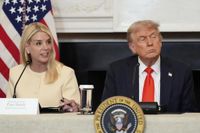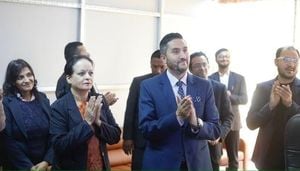As tensions rise between the federal government and state officials over the deployment of the National Guard in major U.S. cities, a legal and political standoff is unfolding in Illinois. The heart of the matter is President Donald Trump’s consideration of invoking the Insurrection Act—a rarely used federal law that grants the president sweeping authority to deploy military forces domestically—in response to what the administration describes as rampant lawlessness in cities like Chicago and Portland. But Illinois leaders, joined by counterparts in other states, are pushing back hard, arguing that the legal threshold for such extraordinary intervention simply hasn’t been met.
On October 13, 2025, Illinois Governor JB Pritzker appeared on ABC News’ “This Week” and minced no words: “The Insurrection Act is called the Insurrection Act for a reason. There has to be a rebellion. There has to be an insurrection in order for him to be allowed to invoke it.” Pritzker’s comments came amid a weekend marked by increased National Guard presence in the Chicago area and mounting speculation that President Trump might move to assert federal control over state troops, a move that would escalate the already fraught relationship between the White House and blue-state governors.
The legal backdrop for this controversy is the Insurrection Act of 1807, which was signed into law by Thomas Jefferson. As reported by NBC News, the Act serves as an exception to the Posse Comitatus Act, which generally prohibits the use of military forces for civilian law enforcement. The Insurrection Act permits the president to use the military to suppress “insurrections” or “rebellions,” but the law itself does not precisely define those terms. According to the Brennan Center for Justice, presidents have invoked the Insurrection Act 30 times since its original version—the Calling Forth Act of 1792—was codified. Notable instances include George Washington’s deployment of troops during the Whiskey Rebellion, Abraham Lincoln’s use of the Act during the Civil War, Ulysses Grant’s efforts to quell Ku Klux Klan violence during Reconstruction, and George H.W. Bush’s response to the 1992 Los Angeles riots.
President Trump, for his part, has made clear that he views recent protests and unrest in cities like Portland as justification for such measures. “I’d do it if it was necessary. So far, it hasn’t been necessary, but we have an Insurrection Act for a reason. If I had to enact it, I’d do that,” Trump told reporters last week. He has repeatedly described the demonstrations as “criminal insurrection,” language that signals his willingness to use the Act if he believes local and state officials are failing to restore order. Vice President JD Vance echoed this sentiment, telling NBC News’s Kristen Welker, “The president’s looking at all of his options… The president just wants people to be kept safe, and we’re exploring everything we can do to make sure the American people are safe in their own country.”
Yet, the legal and political obstacles are formidable. On Saturday, the Seventh Circuit Court of Appeals upheld a ruling from U.S. District Judge April Perry denying the White House’s request to deploy National Guard troops directly onto Chicago streets. However, the court did grant a temporary stay, keeping those troops under federal control for the time being. According to CBS News, the White House contends that National Guard troops are necessary to protect U.S. Immigration and Customs Enforcement (ICE) agents and facilities in Illinois, not because of any insurrection or rebellion. “Amidst ongoing violent riots and lawlessness, that local leaders like (Illinois Gov. JB) Pritzker have refused to step in to quell, President Trump has exercised his lawful authority to protect federal officers and assets,” said White House spokesperson Abigail Jackson. “President Trump will not turn a blind eye to the lawlessness plaguing American cities and we expect to be vindicated by a higher court.”
Meanwhile, the U.S. Department of Homeland Security (DHS) has announced stepped-up operations in Chicago and other cities. “We are deploying additional resources to apprehend rioters and Antifa members engaged in domestic terrorism,” said Micah Bock, Deputy Assistant Secretary for Strategic Communications at DHS, in a social media video. On Sunday, DHS leaders vowed to increase operations “in Portland, Chicago, and across our nation.”
The increased federal presence has created palpable tension on the ground. On October 12, video footage captured federal officers stopping motorists in Chicago’s Rogers Park neighborhood. At St. Jerome Church, some parishioners remained inside after warnings of nearby ICE activity. Local leaders from the western suburbs condemned ICE’s actions and demanded the removal of a fence outside the Broadview ICE facility, which had been erected on September 23. The fence, which blocked a public road and could have impeded first responders, became a flashpoint in the ongoing dispute.
Last week, a federal judge approved a request to dismantle the fence, a decision hailed as a win for public safety by Broadview Mayor Katrina Thompson. Illinois House Speaker Emanuel “Chris” Welch didn’t mince words, calling the fence “a symbol of Donald Trump’s contempt for this community and so many like it.” Drawing a dramatic historical parallel, Welch said, “Just as the Berlin Wall did in 1961, this fence stands as a symbol of division. This fence is a symbol of dividing families. This fence is a symbol of dividing communities. This fence is a symbol of dividing Americans, and this fence is a symbol of denying Americans constitutional rights.”
In another development, Mayor Thompson signed an executive order, in consultation with Illinois State Police and the Cook County Sheriff’s office, restricting protests outside the ICE processing center to a designated safety zone on Beach Street. Protests would no longer be permitted at 2000 S. 25th Ave. between Lexington and Fillmore streets, following chaotic demonstrations on the night of October 11. As of the morning of October 13, the fence outside the ICE facility still stood, a lingering sign of the ongoing standoff.
Governor Pritzker remains confident in the judiciary’s ability to uphold constitutional principles. “We hope to continue to win. Look, we’ve got to rely on the courts to do the right thing. I realize that sometimes that’s risky business, especially when some have been appointed by Donald Trump. But we’ve seen that even a Trump-appointed judge out in California, in the West Coast, has ruled against the administration,” Pritzker said on ABC News. “So I do think that their oath of office actually matters to them, and that they’ll make the right determinations.” Illinois Attorney General Kwame Raoul echoed this optimism, calling the court’s decision a “victory” for Illinois.
Across the country, other blue-state governors have voiced similar opposition. Oregon Governor Tina Kotek, for instance, insisted there is “no need for military intervention in Oregon. There is no insurrection in Portland. No threat to national security,” she wrote on Facebook. The ongoing legal wrangling and rhetorical sparring underscore the profound disagreements over the appropriate use of federal power, the meaning of “insurrection,” and the balance between public safety and civil liberties.
As the nation watches these legal and political battles play out, the outcome will likely set important precedents for the use of federal authority in times of civil unrest. For now, the fence in Broadview and the National Guard’s uncertain status in Chicago stand as concrete reminders of a nation grappling with questions of law, order, and the limits of presidential power.




